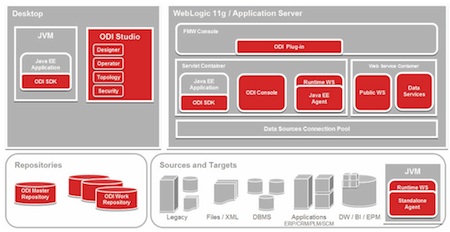 .
.
Oracle Data Integrator (ODI) is an E-LT (Extract – Load & Transform) based data transformation and integration tool. This post covers overview (and architecture) of ODI 11g, for ODI 10g (earlier Sunopsis) click here
ODI consists of following components
1. ODI Studio – is a design time components which consists of Designer, Operator, Topology and Security Navigator. This is developer tool and used mainly by developers and administrators to develop and manage ODI . ODI studio is NOT required at run time.
2. Agents – This is run time component which connects to repository and executes the code . Agents also records execution time, logging, and messages for each execution. Agents are of two type a) Standalone Agents b) Java EE agents.
Both type of agents are mulct threaded java programs and can be configured for high availability. Java EE agents require WebLogic Server where as Standalone Agents run in their own JVM container (no application server is required for standalone agent)
3. ODI Repository- is database schema which contains configuration information, metadata, project scenario and execution logs. ODI repository consists of one Master Repository and multiple Work Repository.
a) Master Repository - contains security information (users, profiles, access rights), topology definition (server , schemas, contexts, languages), versions and achieved objects.
b) Work Repository – contains developed objects like Models, Projects and Scenario execution.
b) Work Repository – contains developed objects like Models, Projects and Scenario execution.
Execution Repository – This is work repository which contains only execution information like for production environment.
4. ODI Console- is a Web based User Interface (accessible via browser) which can be used to perform topology configuration, production operations and read access to ODI repository. ODI Console is a web application and can be deployed on J2EE application server like Oracle WebLogic Server.
5. Public Web Services- ODI comes with several run-time service like a) “Public Web Service” b) “Agent Web Service” which can be deployed and executed from J2EE Application Server like Oracle WebLogic Server. Agent Web Service can also be invoked from Standalone Agent.
a) Public Web Service connects to ODI repository to retrieve list of contexts and scenarios in ODI
b) Agent Web Service commands the ODI Agent (Standalone and Java EE) to start and monitor a scenario in ODI.
b) Agent Web Service commands the ODI Agent (Standalone and Java EE) to start and monitor a scenario in ODI.
Key points for Installing ODI 11g
1.You can install ODI 11g with or without WebLogic (depending on components you select). If you planning to use Java EE Agents, ODI Console, or Public Web Services then WebLogic Server is required.
2.If you are planning to use WebLogic Server (Java EE Agent or ODI Console) on 64 bit machine then use JAR version of WebLogic Server. More here to install WebLogic on 32 bit machine click here
3. Oracle Database is required for Master and Work Repository
4. Master and Work Repository Schema can be created using Repository Creation Utility (RCU). More on RCU here here
5. ODI Installation Type consists of
a) Developer Installation (ODI Studio, ODI SDK)
b) Standalone Installation (ODI Installation Agent)
c) Java EE Installation (Java EE Agent, ODI Console, Public Web Service)
a) Developer Installation (ODI Studio, ODI SDK)
b) Standalone Installation (ODI Installation Agent)
c) Java EE Installation (Java EE Agent, ODI Console, Public Web Service)
High Level Installation steps for ODI
1. Create a database which will hold Master and Work Repository schema
2. Run RCU schema to create master repository
3. If you are planning to use Java EE Agents, ODI Console or Public Web Service then install WebLogic Server
4. Install ODI software (ODI Studio, ODI SDK, ODI Standalone Agent, Java EE Agent, ODI Console, Public web Service). Note : ODI Studio and ODI SDK is required only for development environments. There is no need to install ODI Studio or ODI SDK on production instance. You can use either Standalone Agent or Java EE Agent or both in production environment.
5. If you wish to use Java EE Agent, ODI Console, or Public web Service then create WebLogic Domain and select these components from Domain Template.
6. If you are using Standalone Agents you can additionally configure Oracle Process Manager and Notification (OPMN) server to manage (start, stop, restart) Standalone Agent
Source: